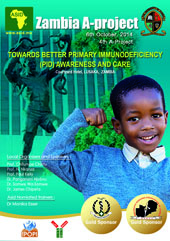Rasha H El-Owaidy, MD, PhD; lecturer of Pediatrics and Clinical Immunology. Faculty of Medicine, Ain Shams University, Cairo, Egypt
Introduction:Hyper immunoglobulin M (HIGM) syndrome results from a variety of genetic defects that affect the interaction between T-lymphocytes and B-lymphocytes leading to inability to switch from the production of antibodies of the IgM type to antibodies of the IgG, IgA or IgE types.
The most common form of HIGM syndrome is the X-linked inherited type that results from a defect or deficiency of a protein found on the surface of activated T-lymphocytes, called CD40 ligand (CD154) which normally binds, or ligates, to a protein receptor on B-lymphocytes called CD40. CD40 ligand is also important for other functions of T-lymphocytes. Therefore, patients who have CD40 ligand deficiency are susceptible to all kinds of infections, particularly opportunistic infections, and to some types of cancer. Some autosomal recessive forms of HIGM syndrome result from defects in genes that are involved in the CD40 signaling pathway in the B cell (T cell functions are not affected). A defect in another X-linked gene (NEMO) leading to a form of HIGM syndrome that is associated with ectodermal dysplasia has been identified. Most patients develop clinical symptoms during their first or second year of life in the form of recurrent upper and lower respiratory tract infections. Diarrhea and malabsorption also occur commonly in XHIGM and CD40 deficiency especially by Cryptosporidium causing sclerosing cholangitis. Approximately half of the patients with XHIGM or CD40 deficiency develop neutropenia. Autoimmune disorders may also occur. XHIGM should be considered in any boy presenting with severe recurrent respiratory infections or an opportunistic infection who has low or absent IgG and normal or elevated IgM levels. Failure to express CD40 ligand on activated T-cells is a characteristic finding. The exact diagnosis of XHIM syndrome depends on the identification of a mutation affecting the CD40 ligand gene. The autosomal recessive forms of HIGM can be suspected if a patient has the characteristics of XHIGM but is either a female and/or has a normal CD40 ligand gene with normal expression on activated T-lymphocytes. NEMO can be suspected in a patient who has features of ectodermal dysplasia. Treatment: immunoglobulin replacement therapy in addition to Pneumocystis jiroveci prophylaxis. When present, neutropenia may also improve during IgG replacement. Bottled water should be used to avoid exposure to Cryptosporidium. Hematopoietic stem cell transplantation has been performed successfully in many patients.
Case: Ourcase is a 3.5 years old boy, third in order of birth of first cousin consanguineous parents. The boy presented with history of recurrent attacks of prolonged fever, recurrent otitis media, bronchopneumonia and chronic diarrhea since the age of 7 months. On examination, the patienthad hepatosplenomegaly and generalizedlymphadenopathy. His blood picture showed intermittent neutropenia, atypical lymphoid hyperplasiaand increased myeloid precursors in bone marrow. Flowcytometry results for B cell and T cell subsets were normal. Immunoglobulin profile showed increased IgM level (4651 mg/dl)and undetectable levels of IgA, IgGand IgE. Family history revealed a previous female sibling death at the age of 4.5years with similar clinical picture.
In view of these data, the diagnosis of HIGM syndrome with autoimmune manifestations was put forward. However, CD40 measurement on B lymphocytes and CD154 measurement on activated T-cells by flowcytometry are still required to differentiate between X-linked and autosomal recessive forms in addition to genetic analysis to identify the underlying genetic defect. This case highlights the importance to suspect primary immunodeficiency in childrenpresenting with autoimmune manifestations.
References:
- Buckley RH. The immunologic system and disorders. In: Behrman RE, Kliegman RM, Jenson HB, editors. Nelson textbook of pediatrics. 19th edn. Philadelphia: WB Saunders; 2011. p. 680-742.
- Vickery JD, Michael CF, Lew DB. Evaluation of B lymphocyte deficiencies. Cardiovasc Hematol Disord Drug Targets 2013;13(2):133-43.
- Hyper IgM Syndromes. Immunodeficiency Foundation. Website URL:http://primaryimmune.org/about-primary-immunodeficiencies/specific-disease-types/hyper-igm-syndromes. Last updated 2013.



























